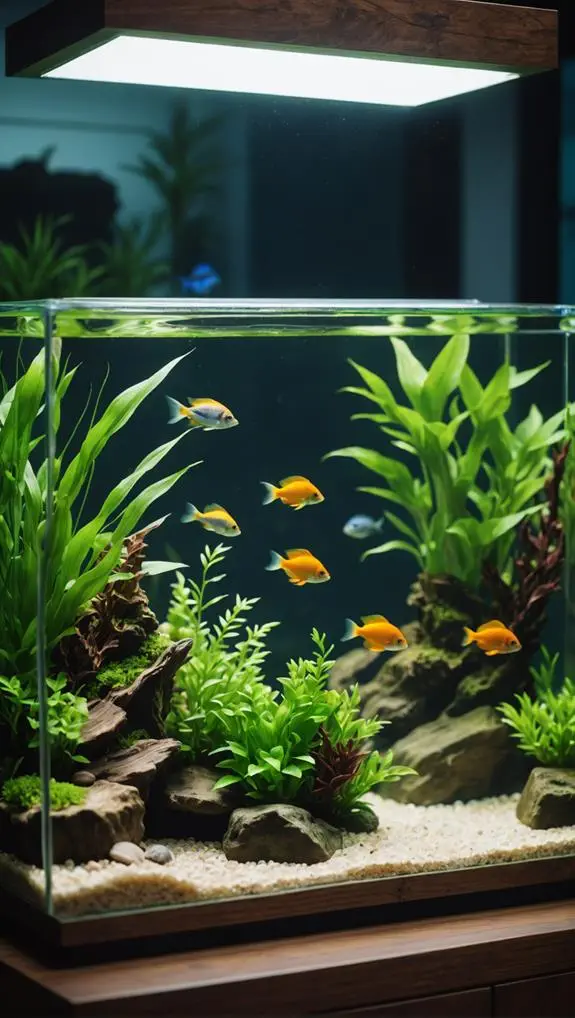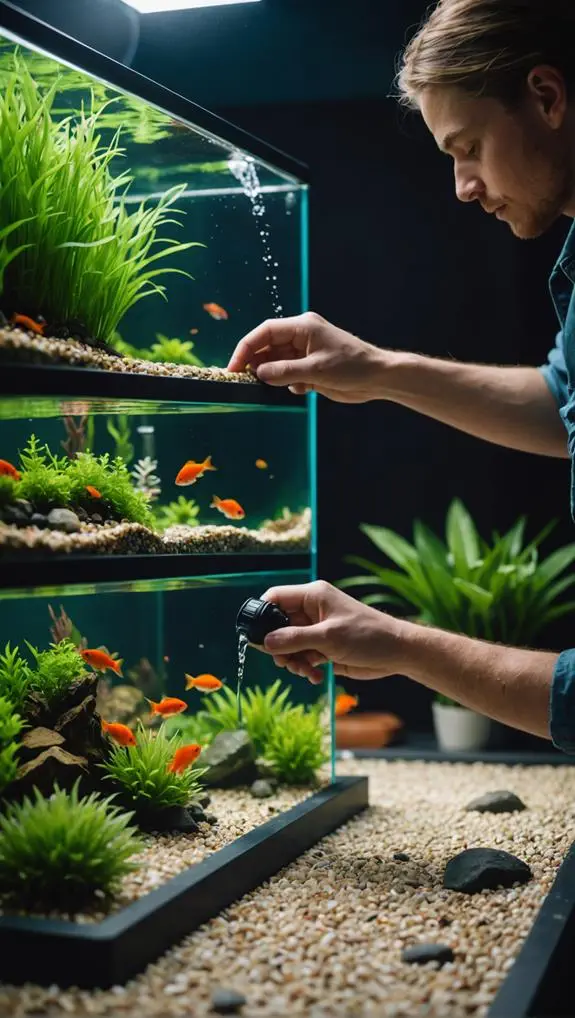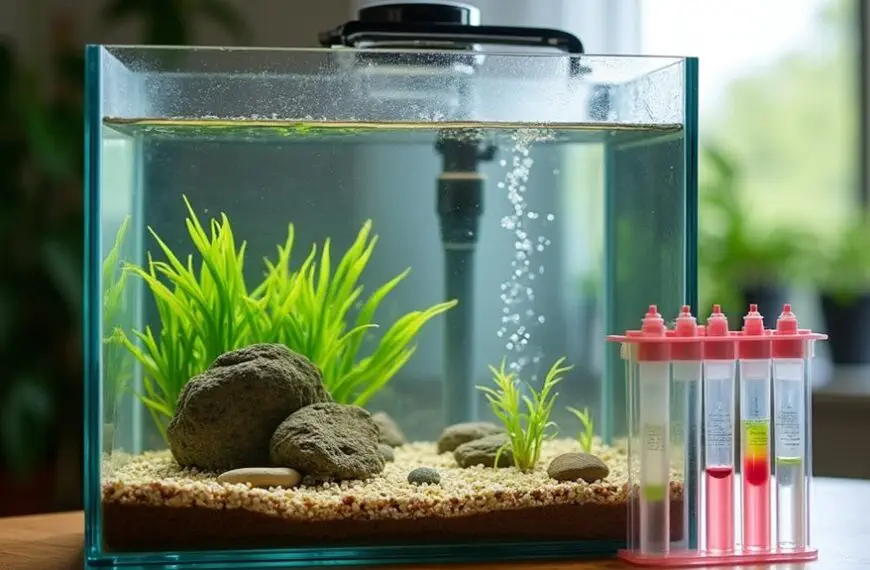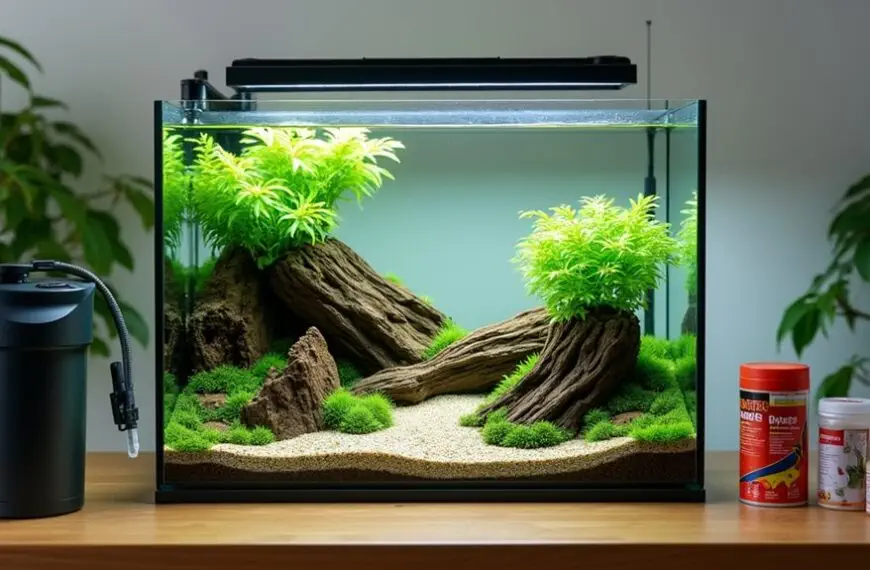Setting up your first fish tank can feel overwhelming, but it doesn't have to be! Start by cleaning everything without soap—just water will do. Then, use a quality dechlorinator for your tap water, set up a good filter, and find a nice spot away from direct sunlight. Bigger tanks are easier to manage, so consider going for 25 gallons or more. Make sure your fish get acclimated slowly and monitor water quality regularly. Oh, and remember, every fish deserves a comfy hideout! Stick around and you'll find even more tips to make your aquarium a splash hit.
Contents
- 1 Prepare Your Aquarium Environment
- 2 Budgeting for Your Fish Tank
- 3 Choosing the Right Aquarium Type
- 4 Selecting Substrate and Decorations
- 5 Steps for Setting Up a Tank
- 6 Understanding the Cycling Process
- 7 Maintaining Water Quality
- 8 Proper Lighting for Aquatic Life
- 9 Introducing Fish Gradually
- 10 Ongoing Maintenance Tips
- 11 Frequently Asked Questions
- 12 Final Thoughts
Prepare Your Aquarium Environment
Creating the perfect aquarium environment is crucial for your fish's health and happiness. Start by thoroughly washing all gravel, rocks, and decorations with warm water—no soap or detergents, please! They're toxic to fish, and we don't want that.
When you fill the aquarium for the first time, pour the water gently using a plate. This helps avoid disturbing the substrate, and filling it only one-third full at first makes things easier.
Next, it's time to de-chlorinate your tap water. Use a quality water conditioner like Tetra AquaSafe Solution. This step ensures your fish can swim safely, free from harsh chemicals.
After that, set up an aquarium filter to keep the water clean and help establish beneficial bacteria, which are essential for your tank's ecosystem.
Don't forget about aeration! An air pump with stones or decorations can really help. Make sure to secure the pump beneath the tank to prevent any backflow.
Lastly, if you're adding live plants, keep them moist before planting so their roots can settle nicely in the gravel. Your fish will thank you for creating a beautiful, healthy home!
Budgeting for Your Fish Tank
When it comes to budgeting for your fish tank, it's more than just picking a pretty aquarium.
You'll want to account for the essential equipment like filters and heaters, which can add up quickly, and don't forget about those sneaky ongoing costs like fish food and electricity.
Initial Setup Costs
Budgeting for your fish tank can be a bit overwhelming, especially since initial setup costs often exceed expectations due to hidden expenses. To get you started, you should plan to spend around $200 or more on essential supplies.
These costs add up quickly, but they're crucial for ensuring your fish thrive.
Here's a list of the basics you'll need:
- An appropriately sized aquarium for your space
- A reliable filter to keep water quality high
- A heater to maintain a comfy temperature
- Lighting to brighten your underwater world
- Water conditioner to create a safe environment
Don't forget, the initial setup costs are just the beginning.
You'll also need to factor in ongoing expenses for fish food, replacement filters, electricity, and water conditioning products.
Plus, if you want to spruce up your tank with decorations or test kits, those costs can sneak up on you too!
Essential Equipment Expenses
After you've accounted for the initial setup costs, it's time to zero in on the specific equipment expenses that will make your fish tank thrive.
First up is the aquarium itself. Aim for a larger tank if you can; it helps with chemical balance and offers more space for your fish to swim freely.
Next, don't underestimate the importance of a reliable filter. Sponge filters are great for beginners, as they're easy to maintain and keep your water clean.
You'll also need a quality heater, especially if you plan on keeping tropical fish. Look for adjustable models like the EHEIM Jager, which are trusted for effective temperature control.
Lighting is key too, particularly for planted tanks. LED lights are energy-efficient and often come with timers, so you won't have to worry about turning them on and off daily.
Ongoing Maintenance Budget
Maintaining a fish tank can be surprisingly affordable if you plan wisely.
Having a clear ongoing maintenance budget helps you keep your aquatic friends happy without breaking the bank.
You'll want to set aside funds each month for essentials, and here's a quick list to guide you:
- Water conditioner replacements: About $5-$15 monthly.
- Aquarium food: Expect to spend around $5-$10.
- Electricity costs: This can range from $2-$10 based on your setup.
- Filter media: Replace every 2-4 weeks, costing roughly $5-$15.
- Contingency fund: Set aside $20-$50 for any unexpected expenses.
Investing in a quality water testing kit upfront can save you money in the long run by helping you avoid costly water quality issues.
Plus, you can feel like a fish tank superhero, ensuring your aquatic pals thrive!
With a little planning and care, your ongoing maintenance budget can keep your tank beautiful and your fish healthy.
Choosing the Right Aquarium Type

Choosing the right aquarium type is essential for creating a thriving aquatic environment. You've got a few options, like glass or acrylic tanks.
Glass aquariums are cost-effective and durable, making them popular for beginners. They're less prone to scratches, so you won't be stressing over every little bump. On the other hand, acrylic tanks are lighter and better insulated, which can be a big win for large tanks. Just keep in mind they often come with a higher price tag.
When it comes to size, larger tanks—25 gallons or more—offer better chemical dilution and environmental stability. This is super important for keeping your tropical fish happy and healthy.
Plus, it gives you more room to design your underwater paradise! Make sure you've got a flat, waterproof surface for your aquarium. Rimmed tanks need solid corner support, while avoiding slanted surfaces can save you from disaster.
Lastly, whether you choose a freshwater aquarium or a planted setup, do your homework! Each type requires different equipment and care, so pick what fits your interests and expertise.
After all, you want to create a cozy home for your aquatic friends!
Selecting Substrate and Decorations
When setting up your aquarium, selecting the right substrate and decorations is crucial for your fish's well-being and the overall aesthetics of the tank. You want to create a cozy environment where your fish feel safe and happy.
Start by choosing a substrate that suits your aquatic buddies and plants. Gravel is versatile—about 1.5-2 lbs per gallon works well. If you're feeling fancy, specially formulated plant substrates can help your aquatic plants thrive.
Don't forget to rinse all substrates thoroughly to remove any dust. And when it comes to decorations, think rocks, driftwood, and plants for hiding spots. Not only do they look great, but they also promote comfort and reduce stress for your fish.
Here are some tips to keep in mind:
- Choose the right substrate type: gravel, sand, or plant-specific.
- Rinse substrates to prevent cloudy water.
- Use natural decorations, avoiding soap at all costs.
- Arrange items thoughtfully for water flow and visibility.
- Balance open spaces with cozy hiding spots for timid fish.
With these tips, you'll create a beautiful, welcoming home for your aquatic friends!
Steps for Setting Up a Tank

Alright, let's get your tank set up! First, you'll want to think about where to place it—good lighting and a stable temperature are key.
Once you've got that figured out, it's time to gather your essential equipment, because nothing says "happy fish" like a well-prepped home!
Aquarium Placement Guidelines
Before you set up your aquarium, it's crucial to find the right spot for it. The right aquarium placement can make all the difference in keeping your fish healthy and happy.
Here are some guidelines to help you choose the perfect location:
- Sturdy Surface: Pick a flat, strong surface that can handle the weight of your filled tank. Remember, it's about 10-12 lbs per gallon!
- Avoid Direct Sunlight: Placing your tank in a sunny spot can cause temperature fluctuations and encourage algae growth. No one wants a green tank!
- Easy Access to Electrical Outlets: You'll need power for your filter and heater, so ensure you can reach an outlet without stretching cords across the room.
- Keep It Level: Use a level to check that your tank is even. A slanted surface can stress the glass and lead to cracks—yikes!
- Visibility and Accessibility: Place your aquarium in a spot that's easy to see and maintain, but away from high-traffic areas to avoid disturbances.
With these tips, you're one step closer to creating a beautiful home for your aquatic friends!
Essential Equipment Checklist
Now that you've found the perfect spot for your aquarium, it's time to gather the necessary equipment for setting it up.
First things first, choose a tank size that suits your space—bigger is often better for stability. You'll need a reliable filter that can turn over your aquarium water 3-5 times an hour, along with a heater to keep things cozy for your fish.
Next, grab some high-quality coated or pre-washed gravel, aiming for about 1.5-2 lbs per gallon of water. This helps support those essential biological processes.
Don't forget a water dechlorinator to remove any pesky chlorine from your tap water. Your fish will thank you!
For regular maintenance, a waste vacuum or aquarium siphon will be your best friend.
And to ensure everything is just right, invest in a freshwater master test kit. This will help you monitor crucial water parameters like pH and ammonia levels.
Lastly, stock up on filter cartridges to keep that water crystal clear.
With the right tools, you're on your way to creating a thriving underwater paradise! Happy fish-keeping!
Understanding the Cycling Process
How do you ensure a thriving environment for your fish? Understanding the cycling process is key! This process helps establish beneficial bacteria that convert toxic ammonia and nitrite from fish waste into less harmful nitrate. It usually takes about 4 to 6 weeks, but don't worry, you can speed things up with products like Tetra SafeStart Solution.
As you navigate this journey, keep these tips in mind:
- Use a test kit to monitor ammonia and nitrite levels.
- Be patient; the cycling process takes time.
- Consider a fishless cycling method to avoid stressing your future fish.
- Make regular water changes to maintain stability.
- Celebrate the little victories as your tank transforms!
During this process, it's crucial to ensure ammonia and nitrite levels hit zero before introducing your fish.
If you rush things, you might end up with a tank that resembles a toxic soup, and that's no fun for anyone!
Maintaining Water Quality

Maintaining water quality is essential for the health of your fish and the overall success of your aquarium. You want your aquatic friends to thrive, right?
Start by regularly testing your water parameters like pH, ammonia, nitrite, and nitrate. Keeping these levels in check is key to a happy tank.
Don't forget to perform monthly partial water changes of about 25%. This helps remove fish waste and keeps the water clear and fresh. A good quality water conditioner is your best friend here—make sure to use it to eliminate chlorine and chloramines from tap water before adding it to your aquarium.
Also, keep an eye out for signs of trouble. If your water looks cloudy, yellowish, or smells funky, it's time for a change!
This way, you'll create a healthy environment for your fish and keep them swimming happily.
Proper Lighting for Aquatic Life
Creating a thriving environment for your fish goes beyond just water quality; proper lighting plays a significant role too. The right aquarium light can enhance fish health and make your tank a stunning focal point in your home.
To keep things balanced, aim for a lighting schedule of 6-8 hours for non-planted tanks and 10-12 hours for planted ones.
Here are some tips to keep in mind:
- Choose LED lighting: They're energy-efficient, produce less heat, and last longer than traditional bulbs.
- Use a timer: This helps maintain a consistent lighting schedule, so your fish enjoy their day and night cycles.
- Place lights evenly: Ensure light distribution is uniform to avoid dark spots that can stress your fish.
- Regularly clean fixtures: Keeping lights clean prevents algae buildup, which can hinder brightness.
- Observe your fish: Watch how they respond to different lighting; it helps you adjust for optimal comfort.
With proper lighting, not only do your fish thrive, but your aquarium will shine, creating a beautiful underwater world that you and others can enjoy!
Introducing Fish Gradually

When it comes to introducing fish to your new tank, patience is key!
Start by quarantining any new arrivals for a couple of weeks, just in case they're hiding any sneaky diseases.
Once they're cleared, keep an eye on your water parameters, so you can ensure your aquatic buddies are happy and healthy while they settle in.
Monitor Water Parameters
Before introducing fish to your tank, you should closely monitor water parameters to ensure a safe environment.
It's crucial to test water parameters regularly, as ammonia and nitrite levels must stay at zero for your fish to thrive. Here are some essential tips to keep in mind:
- Regular Testing: Check water chemistry weekly using high-quality test kits like the API Freshwater Test Kit.
- Stable pH Levels: Aim for a stable pH range specific to your fish species. Drastic changes can stress them out—nobody likes that!
- Gradual Introductions: Start with a few compatible species and wait 1-2 weeks before adding more. This helps beneficial bacteria adapt to the new waste load.
- Watch for Signs: Keep an eye on your fish's behavior and health after each introduction. Signs of stress could mean your tank's environment isn't quite right.
- Adjust Accordingly: If you notice any issues, don't panic! Adjusting water parameters can often help restore balance.
Quarantine New Arrivals
Quarantining new fish is a crucial step for maintaining the health of your aquarium. Think of it as a welcome party with a health check! Before introducing new fish to the main tank, it's wise to quarantine them in a separate tank for at least 2-4 weeks. During this time, you'll want to monitor for signs of illness—keep an eye out for changes in behavior, appetite, or any unusual swimming patterns.
Maintaining consistent water quality in the quarantine tank is key. Regularly check ammonia, nitrite, and nitrate levels to ensure a healthy environment. It's also a good idea to treat new arrivals with a quality dechlorinator and provide proper heating and filtration. This helps create a stable environment, making them feel more at home.
When you're ready to introduce your fish, do it gradually. Rotate the quarantine process by adding just 1-2 fish at a time. This way, you can ensure everyone gets along swimmingly!
Ongoing Maintenance Tips
To keep your fish tank thriving, consistent ongoing maintenance is essential. Think of it as providing a cozy home for your aquatic friends. With just a little effort, you can ensure they live happily and healthily.
Here are some tips to keep things flowing smoothly:
- Test water parameters regularly, including pH, ammonia, nitrite, and nitrate. This helps maintain a stable environment.
- Perform monthly water changes of about 25% to keep the water quality high and reduce waste buildup.
- Clean filter cartridges every 2-4 weeks. This keeps your tank crystal clear, but don't throw them out too often—just rinse them!
- Use a siphon-operated gravel vacuum during water changes. It's perfect for removing uneaten food and debris without disturbing beneficial bacteria.
- Monitor fish behavior closely. If they seem stressed or sick, it might be a sign that something's off in their world.
Frequently Asked Questions
How Do I Prepare My Fish Tank for the First Time?
Did you know that over 50% of beginner aquarists struggle with tank cycling? To prepare your fish tank, focus on filter setup, ensure proper water conditions, and choose appropriate substrate types for a thriving aquatic environment.
How Long Before Adding Fish to a New Tank?
You should wait about 1-2 weeks during the cycling process to establish the nitrogen cycle. Monitor ammonia and nitrite levels closely, ensuring fish compatibility before adding any. Proper tank maintenance guarantees a healthy environment for your pets.
How Long Do Fish Stay in the Bag Before Putting in the Tank?
You've got to keep fish in the bag for no more than two hours. To ensure stress reduction, float the bag for 15-20 minutes for temperature adjustment, then gradually start the acclimation process before release.
Do You Put Water or Gravel in First?
You should place gravel in first for stability. This creates a substrate layer that supports tank cycling. After that, gently fill with water, ensuring optimal water levels for your fish's new home.
Final Thoughts
Setting up your first fish tank can feel like a fish out of water, but with a bit of planning and patience, you'll create a thriving underwater paradise. Remember, you're not just filling a tank; you're building a home for your finned friends. Keep an eye on water quality, introduce your fish gradually, and enjoy the process. Before you know it, you'll have a vibrant ecosystem right in your living room. Dive in and have fun!












